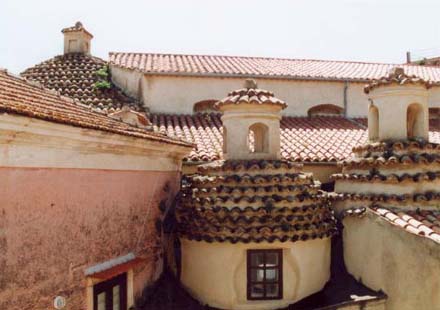|
During the month dedicated to the devotion
of the Saint, there were many so called fantolini dressed
in small Franciscan garbs, similar to those used by our Saint.
It was also customary to call upon Saint Anthony every time something
was lost via the recital of a prayer known as the Dispensorio
di Sant’Antonio:
"Sant’Antoni
meu benignu
di pregari non su degnu
pe’ sta cosa chi perdivi
a Sant’Antoni ricurrivi
ricurrivi o Tabernaculu
Sant’Antoni faci u miraculu
Sant’Antoni meu marinaru
Cacciatimi sta cosa o chjianu".
The person, told to repeat
these verses, had to do so in silence and one could only be sure
of the Saint'’ help in successfully finding the lost object if
the verses were said fluently without hesitation and without interruption
and not omitting any word or verse.
It was very common practice to turn to our
Saint in order to find lost objects. On this matter A.F. Pavanello
writes: “It certainly dates back to the most ancient times because
the Si quoeris contains the known verses:
Membra
resque perditas
Petunt et accipiunt
Iuvenes et cani
(youths and elders
seek and receive lost things)
There are no specific facts which gave origin
to this trust on behalf of the believers. Some think that Giuliano
da Spira, in his Responsorio, was alluding to the Salterio
stolen from the Saint by a novice and subsequently returned. In
telling the story of the Saint’s activities in Montpellier we
haven’t omitted the extraordinary circumstances which were the
reason for the restitution. In the story our guide was the liber
miraculorum (the book of miracles), but the origin of the
devotion is unknown. It is reasonable to say that experience justifies
and confirms this devotion almost as if Our Lord destined Saint
Anthony to make thieves give back stolen things”. Even the following
innocent tongue twister was linked to the Saint:
"Sant’Antoni
jia e ‘bbenia
mentri lu pani lu benedicia
e lu mari si fici ogghjiu
Sant’Antoni na grazia vogghjiu"

A particular devotion to the Saint was found
in our young women, of marriageable age, who with a Faith not
wholly disinterested, would pass the day in the church at the
feet of his statue with the strong wish of being able to be married
soon. Before reciting the Santo Rosario in chorus, each
girl asked the saint in silence and surely with a mixture of some
malice and some modesty the following verses:
"Sant’Antonio
mio glorioso
tutto amabile amoroso
ottenetemi da Dio
quanto spera il cuore mio"
(
"My glorious Saint Anthony
lovable and loving
obtain for me from God
what my heart wants" )
In our dialect the verse
was more outspoken:
"Sant’Antoni
meu benignu
vui sapiti pecchì vegnu
ca la doti è preparata
vorria
essiri maritata".
On the same theme we cite
the most interesting song in verses in the shape of a dialogue:
figghjiu
"Mamma
mi vinni ‘nsonnu Sant’Antoninu
e mi dissi « ’O Cavaleri randi e poderusu
quantu mi voi dari mu ti sanu tutti i toi doluri ? »
« Ti dugnu la me’rrobba e lu dinaru
puru lu meu palazzu e lu me stari ! »
« Non ‘bbogghjiu la to ‘rrobba nè dinaru
nemmeno lu toi palazzu e lu to stari
eu n’orfana ti dugnu a maritari
chi all’artaru meu soli veniri. »
mamma
«
Figghjiu non dari creditu allu sonnu
jiamu alla chiesa pe ’non fari errori. »
Jiru alla chiesa e la’ trovaru dani,
e pedi d’u sant’artaru chi ciangia.
«
Levati
figghjia e non ciangiri cchjiuni
ca eu ti vegnu mamma e tu mi veni nora. »
Nu vecchjiu vestitedu nci cacciaru
Nu riccamentu d’oru nci mentiru
comu lu matrimoniu si dicia
lu Cavaleri m’pedi si lurgia.
Quandu lu matrimoniu s’annunciau
lu Cavaleri ‘mpedi caminau.
Viti chi miraculu divinu
chista la maritau Sant’Antoninu
The musicality of the popular
verse which has the innate pleasure of telling its story, manifests
itself in the ardour of a lullaby which underlines a visceral
love for the Saint; by and by the intensity of the words make
it more familiar so much that it ends with the soft pet name “Sant’Antoniu”.
The highest manifestation of the devotion
to the Saint on behalf of our people is still represented by the
rite of making the thirteen loaves of bread.
|

